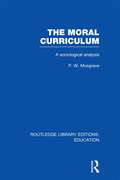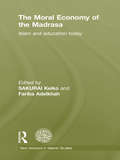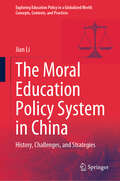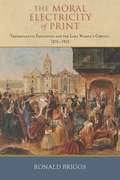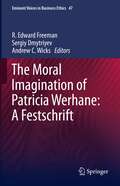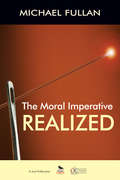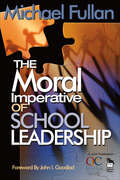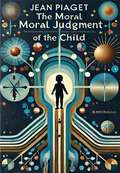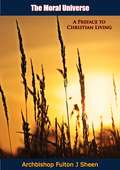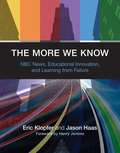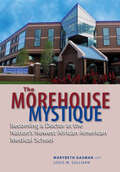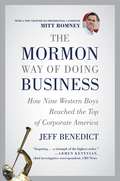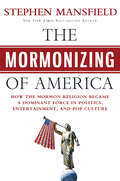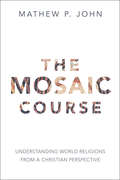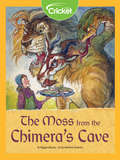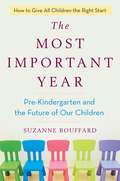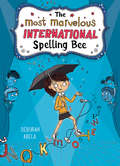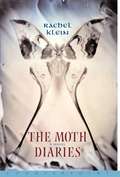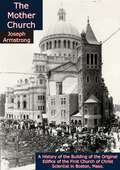- Table View
- List View
The Moral Curriculum: A Sociological Analysis (Routledge Library Editions: Education)
by P W MusgraveTeachers are, and always have been seen as agents of respectability in our society, but today this role is far less easily defined than it once was. Now, for most teachers, the whats and hows of moral behaviour, guidance and instruction have become debatable issues. In this book the author gives us a readable and original sociological consideration of the teaching ‘oughts’ and ‘ought-nots’ which, by providing a valuable analytic framework within which to view moral education, should help the thinking of those who are concerned with some of the most intractable problems of contemporary education.
The Moral Dimensions of Teaching: Language, Power, and Culture in Classroom Interaction
by Bill Johnston Cary BuzzelliCary Buzzelli and Bill Johnson reinvigorate the enduring question: What is the place of morality in the classroom? Departing from notions of a morality that can only be abstract and absolute, these authors ground their investigation in analyses of actual teacher-student interactions. This approach illuminates the ways in which language, power and culture impact "the moral" in teaching. Buzzelli and Johnson's study addresses a wide range of moral issues in various classroom contexts. Its practical and diverse examples make it a valuable resource for teachers and teacher development programs.
The Moral Economy of the Madrasa: Islam and Education Today (New Horizons in Islamic Studies)
by Fariba Adelkhah Sakurai KeikoThe revival of madrasas in the 1980s coincided with the rise of political Islam and soon became associated with the "clash of civilizations" between Islam and the West. This volume examines the rapid expansion of madrasas across Asia and the Middle East and analyses their role in society within their local, national and global context. Based on anthropological investigations in Afghanistan, Bangladesh, China, Iran, and Pakistan, the chapters take a new approach to the issue, examining the recent phenomenon of women in madrasas; Hui Muslims in China; relations between the Iran’s Shia seminary after the 1979-Islamic revolution and Shia in Pakistan and Afghanistan; and South Asian madrasas. Emphasis is placed on the increased presence of women in these institutions, and the reciprocal interactions between secular and religious schools in those countries. Taking into account social, political and demographic changes within the region, the authors show how madrasas have been successful in responding to the educational demand of the people and how they have been modernized their style to cope with a changing environment. A timely contribution to a subject with great international appeal, this book will be of great interest to students and scholars of international politics, political Islam, Middle East and Asian studies and anthropology.
The Moral Education Policy System in China: History, Challenges, and Strategies (Exploring Education Policy in a Globalized World: Concepts, Contexts, and Practices)
by Jian LiThis book examines the moral education policy system in China, discussing the challenges of promoting moral education policy in the country, and proposes relative strategies. It explores the moral education policy in China from various perspectives, including in preschool education, primary education, higher education, vocational type-based higher education, secondary vocational education, English education, music education, classroom teaching, citizenship education, and Chinese language education. This book serves as a guide for scholars and researchers who are interested, and work in, research on moral education policy in China, administrators, stakeholders in China's education system, and graduate students who major or minor in the field of moral education policy in China.
The Moral Electricity of Print: Transatlantic Education and the Lima Women's Circuit, 1876-1910
by Ronald BriggsMoral electricity—a term coined by American transcendentalists in the 1850s to describe the force of nature that was literacy and education in shaping a greater society. This concept wasn't strictly an American idea, of course, and Ronald Briggs introduces us to one of the greatest examples of this power: the literary scene in Lima, Peru, in the nineteenth century.As Briggs notes in the introduction to The Moral Electricity of Print, "the ideological glue that holds the American hemisphere together is a hope for the New World as a grand educational project combined with an anxiety about the baleful influence of a politically and morally decadent Old World that dominated literary output through its powerful publishing interests." The very nature of living as a writer and participating in the literary salons of Lima was, by definition, a revolutionary act that gave voice to the formerly colonized and now liberated people. In the actions of this literary community, as men and women worked toward the same educational goals, we see the birth of a truly independent Latin American literature.
The Moral Electricity of Print: Transatlantic Education and the Lima Women's Circuit, 1876-1910
by Ronald BriggsBest Nineteenth-Century Book Award Winner, 2018, Latin American Studies Association Nineteenth-Century Section Moral electricity—a term coined by American transcendentalists in the 1850s to describe the force of nature that was literacy and education in shaping a greater society. This concept wasn't strictly an American idea, of course, and Ronald Briggs introduces us to one of the greatest examples of this power: the literary scene in Lima, Peru, in the nineteenth century. As Briggs notes in the introduction to The Moral Electricity of Print, "the ideological glue that holds the American hemisphere together is a hope for the New World as a grand educational project combined with an anxiety about the baleful influence of a politically and morally decadent Old World that dominated literary output through its powerful publishing interests." The very nature of living as a writer and participating in the literary salons of Lima was, by definition, a revolutionary act that gave voice to the formerly colonized and now liberated people. In the actions of this literary community, as men and women worked toward the same educational goals, we see the birth of a truly independent Latin American literature.
The Moral Imagination of Patricia Werhane: A Festschrift (Issues in Business Ethics #47)
by R. Edward Freeman Andrew C. Wicks Sergiy DmytriyevThis book celebrates the work of Patricia Werhane, an iconic figure in business ethics. This festschrift is a collection of articles that build on Werhane’s contributions to business ethics in such areas as Employee Rights, the Legacy of Adam Smith, Moral Imagination, Women in Business, the development of the field of business ethics, and her contributions to such fields as Health Care, Education, Teaching, and Philosophy.All papers are new contributions to the management literature written by well-known business ethicists, such as Norman Bowie, Richard De George, Ronald Duska, Edwin Hartman, Michael Hoffman, Mollie Painter-Morland, Mark Schwartz, Andrew Wicks, and others. The volume is comprised of articles that reflect on Werhane’s work as well as build on it as a way to advance further research. At the end of the festschrift, Pat Werhane provides responses to each chapter. The first chapter of the book also includes the overview of Patricia Werhane’s work and her academic career.The book is written to appeal to management scholars and graduate students interested in the areas of Business Ethics, Modern Capitalism, and Human Rights. Patricia Werhane is one of the most distinguished figures in the field of business ethics. She was a founder of the field, she is one of its leading scholars, and she has had a profound impact on the world of business practice. Among her many accomplishments, Pat is known for her original work on moral imagination, she is an acclaimed authority on employee rights in the workplace, and she is one of the leading scholars on Adam Smith. Having been active in Academia for over 50 years, Werhane is a prolific author of over a hundred articles and book chapters, and the author or editor of twenty-seven books, including Adam Smith and his Legacy for Modern Capitalism, Moral Imagination and Management Decision-Making, and co-authored books Organization Ethics in Health Care, Alleviating Poverty Through Profitable Partnerships, Obstacles to Ethical Decision-Making, Corporate Responsibility: The American Experience, and Research Approaches to Business Ethics and Corporate Responsibility.
The Moral Imperative Realized
by Michael FullanAward-winning author and educational reform expert Michael Fullan shows how to achieve successful local and systemic school reform through the strength of shared leadership.
The Moral Imperative of School Leadership
by Michael FullanThe time has come to change the context of school leadership! The role of the principal is pivotal to systemic school change. That is the fundamental message in The Moral Imperative of School Leadership, which extends the discussion begun in Fullan's earlier publication, What’s Worth Fighting for in the Principalship? The author examines the moral purpose of school leadership and its critical role in "changing the context" in which the role is embedded. In this bold step forward, Fullan calls for principals to become agents as well as beneficiaries of the processes of school change. Concepts explored in-depth include: Why "changing the context" should be the main agenda for the principalship Why barriers to the principalship exist Why the principal should be seen as the COO (chief operating officer) of a school Why the role of the principal should figure more prominently within the system
The Moral Judgment of the Child
by Jean Piaget"The Moral Judgment of the Child" by Jean Piaget is a seminal work in the field of developmental psychology, offering profound insights into how children develop moral reasoning. Piaget, a pioneering psychologist, meticulously examines the stages of moral development from early childhood through adolescence, providing a comprehensive framework for understanding how children distinguish right from wrong.In this influential book, Piaget presents his groundbreaking research based on extensive observations and interviews with children. He explores how children's moral thinking evolves, focusing on the transition from a heteronomous morality, where rules are imposed by authority figures and viewed as unchangeable, to an autonomous morality, where children develop their own sense of justice and fairness based on mutual respect and cooperation.Piaget identifies key factors that influence moral development, such as peer interactions, play, and the child's growing cognitive abilities. He delves into the concepts of intention and consequence, illustrating how children's understanding of these aspects shifts with age and experience. Through detailed case studies and examples, Piaget demonstrates the complexity and variability of moral judgment across different developmental stages."The Moral Judgment of the Child" challenges traditional views of moral development, emphasizing the active role of the child in constructing moral understanding through social interactions and cognitive growth. Piaget's theory has profound implications for education, parenting, and our broader understanding of human development.This book is an essential resource for psychologists, educators, and anyone interested in the intricacies of moral development. Piaget's clear and engaging writing makes complex concepts accessible, while his rigorous research provides a solid foundation for further study. "The Moral Judgment of the Child" remains a cornerstone in developmental psychology, offering timeless insights into the moral lives of children.
The Moral Teaching of Paul: Selected Issues, 3rd Edition
by Victor Paul FurnishIn this expanded and updated third edition of an important work, respected Pauline scholar Victor Paul Furnish presents an analysis of some of Paul's most famous yet often misunderstood ethical teachings.Dr. Furnish enriches his discussion of key Pauline topics including: sex, marriage, divorce, homosexuality, women in the church, and the Church in the world. He pays particular attention to the socio-cultural context of Paul's ministry, the complexity of his thought, the character of his moral reasoning, and the way his thought and reasoning may inform and challenge us today.Victor Paul Furnish is University Distinguished Professor of New Testament, Emeritus at Perkins School of Theology, Southern Methodist University, and general editor of the Abingdon New Testament Commentaries.
The Moral Universe: A Preface to Christian Living
by Archbishop Fulton J SheenIn this book Archbishop Sheen reflects on Christian Ethics and provides guidance on how to improve one’s life.Fulton J. Sheen (1895-1979) was one of the best-loved prelates of twentieth century Catholicism. A prolific writer and orator, a distinguished scholar and teacher, an influential master of the media, Bishop Sheen was one of the most effective communicators of our time. His scores of books have offered inspiration, profound thought, and penetrating analysis of Christian faith and life.
The Moral Vision of the New Testament: A Contemporary Introduction to New Testament Ethics
by Richard B. HaysA leading expert in New Testament ethics discovers in the biblical witness a unified ethical vision -- centered in the themes of community, cross and new creation -- that has profound relevance in today′s world. Richard Hays shows how the New Testament provides moral guidance on the most troubling ethical issues of our time, including violence, divorce, homosexuality and abortion.
The More We Know
by Eric Klopfer Jason HaasIn 2006, young people were flocking to MySpace, discovering the joys of watching videos of cute animals on YouTube, and playing online games. Not many of them were watching network news on television; they got most of their information online. So when NBC and MIT launched iCue, an interactive learning venture that combined social networking, online video, and gaming in one multimedia educational site, it was perfectly in tune with the times. iCue was a surefire way for NBC to reach younger viewers and for MIT to test innovative educational methods in the real world. But iCue was a failure: it never developed an audience and was canceled as if it were a sitcom with bad ratings. In The More We Know, Eric Klopfer and Jason Haas, both part of the MIT development team, describe the rise and fall of iCue and what it can teach us about new media, old media, education, and the challenges of innovating in educational media. Klopfer and Haas show that iCue was hampered by, among other things, an educational establishment focused on "teaching to the test," television producers uncomfortable with participatory media, and confusion about the market. But this is not just a cautionary tale; sometimes more can be learned from an interesting failure than a string of successes. Today's educational technology visionaries (iPads for everyone!) might keep this lesson in mind.
The More We Know: NBC News, Educational Innovation, and Learning from Failure
by Eric Klopfer Jason HaasThe rise and fall of iCue: lessons about new media, old media, and education from an NBC-MIT joint venture into interactive learning.In 2006, young people were flocking to MySpace, discovering the joys of watching videos of cute animals on YouTube, and playing online games. Not many of them were watching network news on television; they got most of their information online. So when NBC and MIT launched iCue, an interactive learning venture that combined social networking, online video, and gaming in one multimedia educational site, it was perfectly in tune with the times. iCue was a surefire way for NBC to reach younger viewers and for MIT to test innovative educational methods in the real world. But iCue was a failure: it never developed an audience and was canceled as if it were a sitcom with bad ratings. In The More We Know, Eric Klopfer and Jason Haas, both part of the MIT development team, describe the rise and fall of iCue and what it can teach us about new media, old media, education, and the challenges of innovating in educational media.Klopfer and Haas show that iCue was hampered by, among other things, an educational establishment focused on “teaching to the test,” television producers uncomfortable with participatory media, and confusion about the market. But this is not just a cautionary tale; sometimes more can be learned from an interesting failure than a string of successes. Today's educational technology visionaries (iPads for everyone!) might keep this lesson in mind.
The Morehouse Mystique: Becoming a Doctor at the Nation's Newest African American Medical School
by Marybeth GasmanThe Morehouse School of Medicine in Atlanta, Georgia, is one of only four predominantly Black medical schools in the United States. Among its illustrious alumni are surgeons general of the United States, medical school presidents, and numerous other highly regarded medical professionals. This book tells the engrossing history of this venerable institution.The school was founded just after the civil rights era, when major barriers prevented minorities from receiving adequate health care and Black students were underrepresented in predominantly White medical schools. The Morehouse School of Medicine was conceived to address both problems—it was a minority-serving institution educating doctors who would practice in underserved communities.The school's history involves political maneuvering, skilled leadership, dedication to training African American physicians, and a mission of primary care in disadvantaged communities. Highlighting such influential leaders as former Health and Human Services Secretary Louis W. Sullivan, The Morehouse Mystique situates the school in the context of the history of medical education for Blacks and race relations throughout the country. The book features excerpts from personal interviews with prominent African American doctors as well as with former presidents Jimmy Carter and George H. W. Bush, who reveal how local, state, and national politics shaped the development of Black medical schools in the United States.The story of the Morehouse School of Medicine reflects the turbulent time in which it was founded and the lofty goals and accomplishments of a diverse group of African American leaders. Their tireless efforts in creating this eminent Black institution changed the landscape of medical education and the racial and ethnic makeup of physicians and health care professions.
The Morganza, 1967: Life in a Legendary Reform School
by David E. StuartFresh out of college, David Stuart put off graduate school to take a job close to his West Virginia home as a counselor at the Youth Development Center at Canonsburg, Pennsylvania. Known locally as the Morganza, the facility was founded in the nineteenth century as a farm for orphaned boys. By the 1960s, the Morganza had long been burdened with a sinister reputation when it was converted into a detention center for Allegheny County youth convicted of crimes ranging from petty theft to armed robbery, rape, and murder. Reporting for duty during the racially turbulent and riot-torn summer of 1967, Stuart describes the life of students and staff in what was, in reality, a youth prison camp. Confronted with the glaring shortcomings of the reform school's methods of rehabilitation, Stuart irritated the bureaucracy, advocating for detainees whose only crimes were a lack of education and belonging to the wrong race or economic class. He confronted an establishment that refused to distinguish between hardened criminals and those who would benefit from actual reform. In The Morganza, 1967 Stuart offers a brutally honest--at times touching--insider's view of a juvenile justice system that was badly in need of fixing.
The Mormon Way of Doing Business: How Nine Western Boys Reached the Top of Corporate America
by Jeff BenedictThe Founder of JetBlue. The former CEO of Dell Computers. The CEO of Deloitte & Touche. The former Dean of the Harvard Business School. They all have one thing in common. They are devout Mormons who spend their Sundays exclusively with their families, never work long hours, and always put their spouses and children first. How do they do it? Critically acclaimed author and investigative journalist Jeff Benedict (a Mormon himself) examines these highly successful business execs and discovers how their beliefs have influenced them, and enabled them to achieve incredible success.With original interviews and unparalleled access, Benedict shares what truly drives these individuals, and the invaluable life lessons from which anyone can benefit.
The Mormonizing of America: How the Mormon Religion Became a Dominant Force in Politics, Entertainment, and Pop Culture
by Stephen MansfieldStephen Mansfield, the acclaimed New York Times best-selling author, has highlighted the growing popularity of Mormonism-a belief system with cultic roots-and the implications of its critical rise. Mormons are moving into the spotlight in pop culture, politics, sports, and entertainment via presidential candidates like Romney and Huntsman, media personality Glenn Beck, mega-bestselling Twilight author Stephanie Meyer, and The Book of Mormon, the hottest show on Broadway. Mormonism was once a renegade cult at war with the U.S. Army in the 1800s, but it has now emerged as not only the fastest-growing religion, but as a high-impact mainstream cultural influence.
The Mosaic Course: Understanding World Religions from a Christian Perspective
by Mathew P. JohnHow do we affirm the biblical notion that Jesus is the only way to God while respecting people of other religious traditions and worldviews? The Mosaic Course: Understanding World Religions from a Christian Perspective answers this complex question by taking readers on an exciting journey exploring hidden revelations of Jesus Christ in world religions. Used in conjunction with the Mosaic Video Series available at themosaiccourse.org, Christians are equipped to engage in open and respectful dialogue with people of differing worldviews. Without compromising the fundamental faith conviction that Jesus is the only way to God, this study guide empowers readers to share their faith with people of other religious traditions in a culturally sensitive fashion.
The Moss from the Chimera's Cave
by Maggie MurphyThe stench from a fearsome chimera rots the food throughout a fairy tale kingdom. The king’s wizard knows how to banish it, but needs one special thing—moss from the chimera’s cave itself. Someone needs to charm the chimera, but how can an honest kitchen boy succeed where clever knights have failed?
The Most Important Year: Pre-Kindergarten and the Future of Our Children
by Suzanne BouffardAn eye-opening look inside pre-K in America and what it will take to give all children the best start in school possible. At the heart of this groundbreaking book are two urgent questions: What do our young children need in the earliest years of school, and how do we ensure that they all get it? Cutting-edge research has proven that early childhood education is crucial for all children to gain the academic and emotional skills they need to succeed later in life. Children who attend quality pre-K programs have a host of positive outcomes including better language, literacy, problem-solving and math skills down the line, and they have a leg up on what appears to be the most essential skill to develop at age four: strong self-control. But even with this overwhelming evidence, early childhood education is at a crossroads in America. We know that children can and do benefit, but we also know that too many of our littlest learners don’t get that chance—millions of parents can’t find spots for their children, or their preschoolers end up in poor quality programs. With engrossing storytelling, journalist Suzanne Bouffard takes us inside some of the country’s best pre-K classrooms to reveal the sometimes surprising ingredients that make them work—and to understand why some programs are doing the opposite of what is best for children. It also chronicles the stories of families and teachers from many backgrounds as they struggle to give their children a good start in school. This book is a call to arms when we are at a crucial moment, and perhaps on the verge of a missed opportunity: We now have the means and the will to have universal pre-kindergarten, but we are also in grave danger of not getting it right.
The Most Marvelous International Spelling Bee (The Spectacular Spelling Bee #2)
by Deborah AbelaA heartwarming story about a girl who is no longer afraid to follow her dreams, and the family who help make them happen.India Wimple can spell with the best of them. How else would she have won the Stupendously Spectacular Spelling Bee and garnered an invitation to the Most Marvelous International Spelling Bee? India couldn't be more thrilled to travel to London along with the rest of the Wimples. And at first, it seems like a dream come true; she reunites with her spelling bee friends, and they even get to meet the Queen! But there is skulduggery afoot, with some rather mysterious goings-on going on and a series of accidents that seem to be not-so-accidental after all. India has her suspicions about who is behind the duplicitous demonstrations. But can she solve the mystery in time to save the competition?
The Moth Diaries
by Rachel KleinAt an exclusive girls’ boarding school, a sixteen-year-old girl records her most intimate thoughts in a diary. The object of her growing obsession is her roommate, Lucy Blake, and Lucy’s friendship with their new and disturbing classmate. Ernessa is an enigmatic, moody presence with pale skin and hypnotic eyes. Around her swirl dark rumors, suspicions, and secrets as well as a series of ominous disasters. As fear spreads through the school and Lucy isn’t Lucy anymore, fantasy and reality mingle until what is true and what is dreamed bleed together into a waking nightmare that evokes with gothic menace the anxieties, lusts, and fears of adolescence. And at the center of the diary is the question that haunts all who read it: Is Ernessa really a vampire? Or has the narrator trapped herself in the fevered world of her own imagining?
The Mother Church, A History of the Building of the Original Edifice of the First Church of Christ Scientist in Boston, Mass.
by Joseph ArmstrongThe Mother Church by Joseph Armstrong offers a detailed and insightful account of the construction of the original edifice of the First Church of Christ, Scientist, in Boston, Massachusetts. Written by someone closely involved in the church’s development, the book serves as both a historical chronicle and a tribute to the vision, faith, and perseverance that made this monumental project possible.Armstrong takes readers behind the scenes of the planning, design, and construction processes, offering vivid descriptions of the challenges faced by the Christian Science community in building their flagship church. The narrative highlights not only the architectural and engineering feats involved but also the spiritual foundation that guided the endeavor, emphasizing the role of Mary Baker Eddy, the founder of Christian Science, in inspiring the project.Beyond bricks and mortar, the book explores the broader significance of the church as a symbol of the growth and establishment of Christian Science during a pivotal time. Armstrong reflects on the collaboration between architects, builders, and congregants, capturing the spirit of unity and purpose that defined the project. He also discusses the obstacles overcome along the way, from financial concerns to construction delays, demonstrating how faith and dedication ultimately triumphed.The Mother Church provides readers with more than just a history of a building—it offers a glimpse into the heart of a spiritual movement and the community that brought it to life. For those interested in the history of Christian Science, architecture, or the power of collective vision, Armstrong’s work is an inspiring and informative read, showcasing how spiritual ideals can shape and manifest in the physical world through shared effort and belief.
